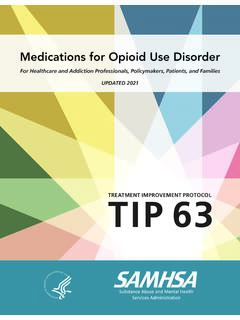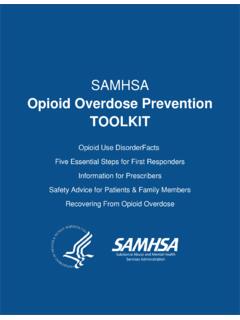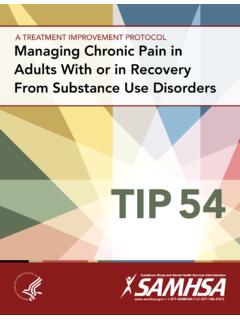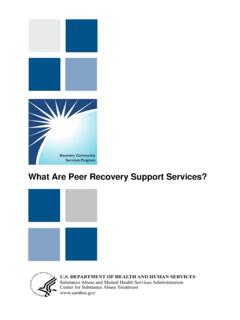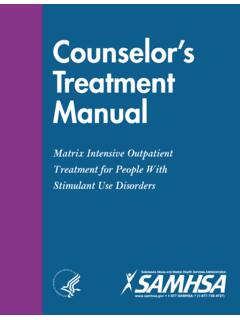Transcription of CLINICAL ISSUES IN INTENSIVE OUTPATIENT TREATMENT …
1 Substance Abuse and Mental HealthServices AdministrationADVISORYPage 1 of 9 CLINICAL ISSUES IN INTENSIVE OUTPATIENT TREATMENT FOR SUBSTANCE USE DISORDERS INTENSIVE OUTPATIENT (IOP) programs for substance use disorders (SUDs) offer services to clients seeking primary TREATMENT ; step-down care from inpatient, residential, and withdrawal management settings; or step-up TREATMENT from individual or group OUTPATIENT TREATMENT . IOP TREATMENT includes a prearranged schedule of core services ( , individual counseling, group therapy, family psychoeducation, and case management [CM]) for a minimum of 9 hours per week for adults or 6 hours per week for adolescents (Mee-Lee et al., 2013). To help clients fulfill their individualized TREATMENT plan goals, IOP services may incorporate other in-house TREATMENT and peer services, encourage clients attendance at mutual-support groups, and collaborate with local community providers to secure needed services ( , medication-assisted TREATMENT , psychological assessments, vocational rehabilitation services, and trauma-specific TREATMENT ).
2 This Advisory, based on the Substance Abuse and Mental Health Services Administration s (SAMHSA) TREATMENT Improvement Protocol (TIP) 47, Substance Abuse: CLINICAL ISSUES in INTENSIVE OUTPATIENT TREATMENT , provides an overview of IOP TREATMENT ; program goals; key features that improve engagement, retention, and outcomes; and resources. Key Messages IOP outcomes are comparable to those seen with residential services for clients with minimal risk of acute intoxication/withdrawal, health conditions, and psychological symptoms. IOP programs provide clients with local comprehensive SUD TREATMENT services and access to other social services in the community, thereby establishing and building a recovery network that can extend beyond TREATMENT . Key IOP program features improve TREATMENT engagement, retention, and outcomes, including shared decision making, mutual-support and recovery activities, CM, and vocational support.
3 IOP TREATMENT is most effective if it is part of a continuum of care. ADVISORY Advantages of IOP TREATMENT The 2019 National Survey of Substance Abuse TREATMENT Services reports that 46 percent of SUD TREATMENT facilities offer IOP TREATMENT (SAMHSA, 2020d). IOP programs offer advantages over residential settings and standard OUTPATIENT services through: Flexibility in TREATMENT delivery. Because IOP programs offer day, evening, and weekend programming, clients can maintain responsibilities outside of TREATMENT , including work, caregiving, parenting, and education. Less restrictive comprehensive TREATMENT . IOP programs offer more INTENSIVE services than traditional OUTPATIENT , while avoiding the restrictions of residential TREATMENT . IOP TREATMENT provides services over a longer period than most residential TREATMENT . IOP services are local, making them less disruptive for clients to manage day-to-day responsibilities.
4 Continuity of care and support. clients engaged in IOP TREATMENT often use local community services and mutual-support groups outside the program. After completion of IOP TREATMENT , these support networks and services remain intact (Kim et al., 2015), easing clients transition into the next phase of recovery. Transitions from residential to OUTPATIENT TREATMENT often require time to create or reestablish a network of services and support. Real-time skills training. IOP programs provide opportunities to practice recovery skills in real time. Because TREATMENT occurs locally, clients can apply newly acquired skills with family and friends, and in other circumstances while still engaged in TREATMENT . By practicing these recovery strategies, clients can build self-confidence a key attribute in making behavioral changes (Romano & Peters, 2016).
5 IOP programs are just as effective as inpatient and residential programs for most individuals who have a lower risk of withdrawal and less symptom severity, and who do not require a 24-hour structured setting. Studies have collectively shown that IOP programs improve abstinence rates, reduce SUD symptom severity, and decrease frequency of substance use (McCarty et al., 2014; Schmidt et al., 2017). In a national study evaluating veterans with SUDs, individuals who attended IOP TREATMENT after medically managed withdrawal were more likely to engage in and utilize services, including those within the community, and had lower 2-year mortality rates (Schmidt et al., 2017). IOP Services: An Overview IOP placement criteria IOP TREATMENT involves comprehensive OUTPATIENT services that meet the needs of those with substance use and co-occurring disorders.
6 A comprehensive, multidimensional assessment of presenting problems, TREATMENT goals, and recovery needs guides the level-of-care determination. clients suitable for the IOP level of care are characterized by the following (Mee-Lee et al., 2013): There is little risk of acute intoxication or withdrawal. Physical health conditions are manageable and will not distract from TREATMENT participation. Emotional, behavioral, and cognitive conditions are mild or treatable on an OUTPATIENT level, but may have the potential to distract from TREATMENT and recovery and therefore require monitoring. Readiness to change fluctuates, highlighting the need for engagement in a structured TREATMENT environment several times a week. Page 2 of 9 SAMHSA s mission is to reduce the impact of substance abuse and mental illness on America s communities. 1-877-SAMHSA-7 | (1-877-726-4727) 1-800-487-4889 (TDD) ADVISORY There is a greater probability of continued use, problems, and relapse without support and monitoring throughout the week.
7 Current environment is not supportive, but added support and structure from an IOP program enables coping. If clients are appropriately placed in IOP TREATMENT , TREATMENT outcomes are comparable to inpatient TREATMENT , but at nearly half the cost (Magura et al., 2003). IOP TREATMENT goals In addition to individualized TREATMENT goals that reflect the client s strengths, recovery challenges, and presenting problems, IOP services characteristically focus on the following objectives: Educating clients about SUDs, patterns and consequences of use, relapse risks, the TREATMENT process, and types of mutual-support groups Providing early recovery, coping, and relapse prevention skills Building recovery supports, including the use of peer support services and mutual-support groups Addressing obstacles to engaging in TREATMENT and maintaining recovery Providing physical and psychological symptom management by monitoring and addressing the symptoms or referring the client, as indicated Engaging families, as defined by the client, and providing education on SUDs, patterns and consequences of use, family dynamics, and TREATMENT and recovery processes Providing emotional support and enhancing motivation Attending to other health and psychosocial needs, including housing, vocational, financial assistance.
8 And other medical and dental needs IOP services SUD IOP programs provide a range of services, schedules, hours, and lengths of care. IOP TREATMENT requirements vary across states and health plans, but generally involve a minimum of 9 hours of client services each week at local facilities. Online synchronous IOP programming and telehealth appointments have steadily evolved to bolster existing services and meet the needs of individuals living in According to the 2017 TREATMENT EpisodeData Set on IOP program discharges, themedian length of stay for those ages 18years and older who complete treatmentis 81 days (SAMHSA, 2019). rural regions. Recently, many IOP programs have transitioned to telehealth models of service delivery in response to the COVID-19 public health emergency (Centers for Medicare & Medicaid Services & SAMHSA, 2020). Individual counseling.
9 Individual counseling typically occurs once a week or as needed. Sessions focus on addressing problems that need more attention or ISSUES that clients are reluctant to raise in group format. Individual counseling services provide an opportunity to check in with clients to address their concerns in the program, provide additional support, and further enhance readiness for change and motivation to support recovery. Page 3 of 9 SAMHSA s mission is to reduce the impact of substance abuse and mental illness on America s communities. 1-877-SAMHSA-7 | (1-877-726-4727) 1-800-487-4889 (TDD) ADVISORY Case management. CM services involve a collaboration between the client and case manager to determine and coordinate access to the most suitable services for supporting the client ( , medical, SUD TREATMENT , behavioral health, and social services; Commission for Case Manager Certification, 2020).
10 Though each IOP program may define CM roles and tasks differently, here are several core CM responsibilities: Assessing and developing individualized plans with clients Coordinating and referring clients to the most appropriate services in house or within the community Monitoring clients follow-through with services and support systems, as well as their outcomes Advocating for clients within TREATMENT and with community agencies to establish and arrange needed services ( , housing, primary care services, financial assistance, vocational services) Promoting and establishing continuity of services when clients transition from one service to another to avoid service gaps Case management in SUD TREATMENT improves clients follow-through with TREATMENT tasks and retention in services, and subsequently improves TREATMENT outcomes (Rapp et al.)

